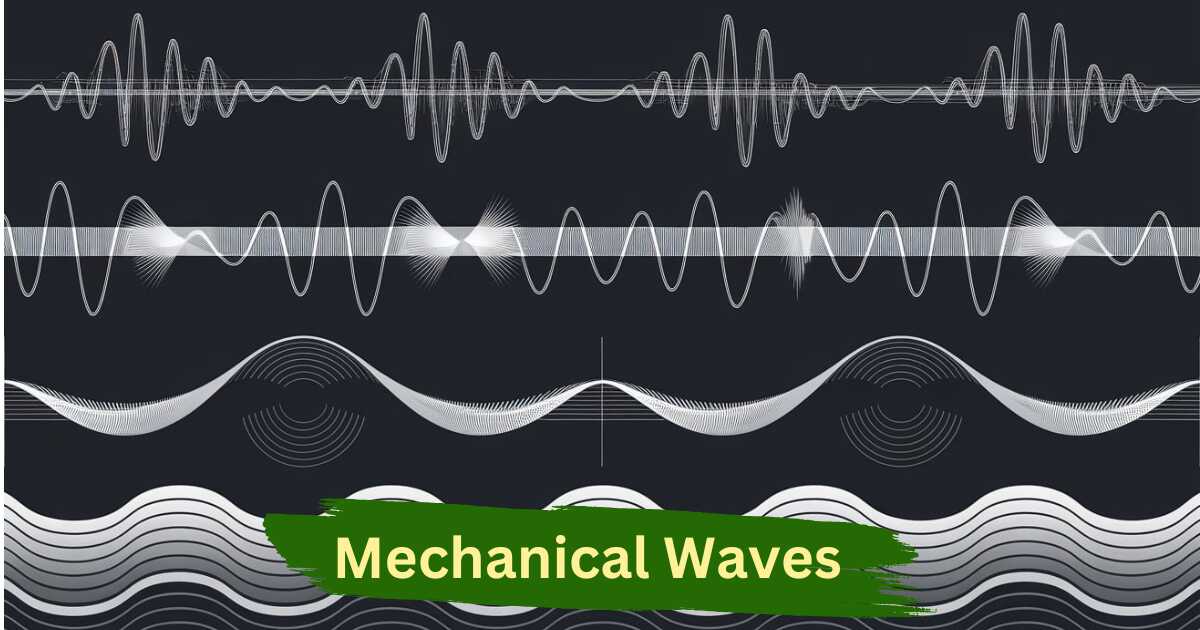Mechanical waves are all around us, shaping the way we experience sound, light, and movement. They travel through mediums like water, air, or solid objects, creating vibrations that our senses can pick up.
Imagine the waves crashing on a beach or the vibrations you feel when you touch a speaker; these are all examples of mechanical waves in action. From ocean waves to the sound of music, mechanical waves connect us to the world in fascinating ways. Understanding them gives us a deeper appreciation for how energy moves and transforms all around us.
What is a Mechanical Wave Definition?
A mechanical wave is a disturbance that travels through a medium. This medium can be air, water, or solid materials.
Unlike light waves, which can move through empty space, mechanical waves need something to travel through. When a wave moves, it causes particles in the medium to vibrate. This vibration transfers energy from one location to another. Examples include sound waves and ocean waves.
Mechanical Wave Definition Chemistry
In chemistry, a mechanical wave is defined as a type of wave that results from the oscillation of particles within a medium, facilitating the transfer of energy through that medium. These waves are crucial for understanding various phenomena, including sound transmission in gases and liquids and the behavior of waves in solids.
In chemical contexts, mechanical waves can influence reactions and processes, such as how sound waves can initiate chemical reactions or how waves affect molecular interactions. Unlike electromagnetic waves, mechanical waves require a physical medium for propagation, making them integral to the study of materials and their properties in chemistry.
Mechanical Wave Definition in Physics
In physics, a mechanical wave is defined as a disturbance that travels through a medium (solid, liquid, or gas) and transfers energy from one point to another without causing any permanent displacement of the particles in the medium.
Mechanical waves rely on the interaction of particles in the medium to propagate, and they can be classified into two main types: transverse waves, where particle displacement is perpendicular to the direction of wave propagation, and longitudinal waves, where particle displacement occurs parallel to the direction of wave travel.
How Mechanical Waves Differ from Other Waves?
Mechanical waves stand out from other types of waves in some key ways. Unlike electromagnetic waves (such as light, radio waves, or X-rays), mechanical waves can’t travel through empty space – they absolutely need some kind of material or substance to move through. Think of it like this: you can’t make ripples without water, and you can’t have sound without air or another medium to carry it.
Another big difference is how they carry energy. When mechanical waves travel, they make the particles of their medium move back and forth or up and down, like when you see a floating toy bob up and down on ocean waves.
This is quite different from electromagnetic waves, which are made of electric and magnetic fields that can zip through the vacuum of space. That’s why we can see sunlight traveling through space, but sound can’t travel in space because there’s no medium to carry it.
The speed of mechanical waves also sets them apart. While electromagnetic waves all travel at the incredible speed of light (about 300,000 kilometers per second in a vacuum), mechanical waves are much slower.
speed depends on what they’re traveling through – sound moves at about 343 meters per second in air, while waves on the ocean might travel at just a few meters per second. This is because mechanical waves rely on actual physical matter to bounce their energy from particle to particle, making them much slower than their electromagnetic cousins.
Types of Mechanical Waves
Transverse Waves
When particles move up and down (or side to side) at right angles to the wave’s direction, we call it a transverse wave. Picture shaking a jump rope up and down – the rope moves vertically while the wave travels horizontally. Ocean waves are another great example of transverse waves, where water particles move up and down as the wave moves forward along the surface.
Longitudinal Waves
In longitudinal waves, particles move back and forth in the same direction that the wave travels. Sound waves are the perfect example – as they move through the air, they create areas where air particles bunch together (compression) and spread apart (rarefaction). If you’ve ever played with a slinky toy by pushing and pulling it, you’ve created longitudinal waves!
Surface Waves
Surface waves are unique because they combine both transverse and longitudinal motion. When you drop a stone in a pond, the ripples you see are surface waves – the water particles move in a circular pattern as the wave spreads outward. These waves only occur at the boundary between two different mediums, like water and air, or along the Earth’s surface during earthquakes. They’re a bit like doing “the wave” at a sports stadium, but with a more complex motion.
How Mechanical Waves Propagate?
Mechanical waves propagate by traveling through a medium, such as air, water, or solids. The medium plays a crucial role in this process. It acts as the pathway that allows the wave to move from one place to another. When a wave begins, it disturbs the particles of the medium.
These particles then vibrate, passing the disturbance along to their neighbors. This chain reaction continues, enabling the wave to travel over distances. The type of medium affects how quickly and efficiently the wave moves. For instance, sound travels faster in water than in air because water molecules are closer together.
Energy moves through the medium as the wave propagates. As particles vibrate, they transfer energy to adjacent particles, causing them to move. This energy transfer is what allows waves to carry sound, heat, and even motion.
In a sound wave, for example, energy travels through air by compressing and rarefying the air molecules. Similarly, in water waves, energy moves through the water by causing the surface to rise and fall. Understanding this process helps us grasp how waves influence our environment and daily lives.
Examples of Mechanical Waves in Daily Life
Mechanical waves are present in many aspects of our daily lives. Here are some common examples:
Sound waves are perhaps the most familiar type of mechanical wave. When someone talks or plays an instrument, vibrations travel through the air to our ears, allowing us to hear. Without air or another medium, we wouldn’t be able to hear sounds.
Another example is water waves. When you throw a stone into a pond, it creates ripples that move outward. These ripples are mechanical waves traveling through the water, transferring energy as they spread.
Seismic waves are another important example. They occur during earthquakes and travel through the Earth’s crust. These waves can cause the ground to shake, impacting buildings and landscapes.
Lastly, waves on a string, such as those created when you pluck a guitar string, illustrate mechanical waves as well. The vibration of the string generates waves that travel along it, producing sound. These examples show how mechanical waves are integral to communication, natural phenomena, and entertainment in our everyday lives.
Applications of Mechanical Waves
Mechanical waves have a wide range of practical applications that impact various fields, including communication, medicine, and oceanography.
Communication
One of the most significant uses of mechanical waves is in communication. Sound waves enable us to talk on the phone, listen to music, or enjoy podcasts. Technologies like sonar and ultrasound also rely on mechanical waves to transmit information. Sonar uses sound waves to detect objects underwater, helping ships navigate and locate underwater features.
Medical Uses
In medicine, ultrasound is a vital application of mechanical waves. This technology uses high-frequency sound waves to create images of the inside of the body. Doctors use ultrasound to examine organs, monitor pregnancies, and diagnose conditions. It is non-invasive and safe, making it a preferred method for many medical evaluations.
Oceanography
Oceanography also benefits from mechanical waves. Scientists study ocean waves to understand currents, tides, and the overall health of marine ecosystems. By analyzing wave patterns, researchers can gather data on weather conditions and climate changes. This information is crucial for predicting storms and managing coastal resources. Overall, mechanical waves play a key role in enhancing our understanding and interaction with the world around us.
Medium Requirement in Mechanical Waves
Mechanical waves require a physical medium to propagate because they depend on the interaction of particles within that medium to transmit energy. Unlike electromagnetic waves, which can travel through a vacuum, mechanical waves need matter—such as solids, liquids, or gases—where particles can collide and transfer energy.
When a mechanical wave travels, it creates disturbances in the medium, causing the particles to vibrate. These vibrations then pass through the medium from one particle to another, enabling the wave to move forward.
Without a medium, there would be no particles to transmit the energy. For example, sound waves cannot travel in space because there are no air particles to carry the vibrations. Similarly, water waves rely on water molecules to propagate.
The characteristics of the medium, such as its density and elasticity, directly influence the speed and behavior of the wave. Understanding the necessity of a physical medium is key to grasping how different types of mechanical waves operate and interact in various environments.
How are mechanical waves produced?
Mechanical waves are produced when a disturbance creates vibrations in a medium. This can happen in various ways, depending on the type of wave. For instance, when you pluck a guitar string, the string vibrates, creating waves that travel along it. These vibrations disturb the surrounding air particles, generating sound waves that can be heard.
In water, mechanical waves are often created by wind. As the wind blows across the surface of a body of water, it transfers energy to the water molecules, causing them to move and form waves. Similarly, when an object, like a stone, is thrown into a pond, it displaces the water, producing ripples that spread outward.
Another example is seismic waves generated by earthquakes. When tectonic plates shift, they create vibrations that travel through the Earth’s crust. These vibrations manifest as seismic waves, which can be detected by seismographs. In all these cases, the initial disturbance causes particles in the medium to vibrate, producing waves that carry energy away from the source.
Mechanical Waves: Types of Mediums
Mechanical waves can travel through different types of mediums, each affecting the wave’s speed and behavior. The primary categories of mediums include solids, liquids, and gases.
Solids:
In solids, mechanical waves travel fastest because particles are closely packed together. The tight arrangement allows for efficient energy transfer. For example, sound waves can move quickly through metal, making it an excellent conductor of sound.
Liquids:
In liquids, such as water, mechanical waves also propagate, though not as quickly as in solids. The particles in liquids are further apart than in solids, which slows down the wave speed. Water waves, like those seen in oceans or lakes, are a common example of mechanical waves in liquids.
Gases:
Mechanical waves can travel through gases, like air, but at a slower speed than in solids and liquids. In gases, particles are much farther apart, which makes it more difficult for energy transfer to occur. Sound waves are a familiar example of mechanical waves traveling through air.
Properties of Mechanical Waves
| Characteristics | Description |
|---|---|
| Amplitude | Maximum displacement of particles from their rest position, indicating wave energy. |
| Wavelength | Distance between two consecutive points in phase, such as crest to crest. |
| Frequency | Number of complete wave cycles that pass a point per unit time, measured in hertz (Hz). |
| Speed | Speed of the wave determined by the medium; calculated as frequency multiplied by wavelength. |
| Period | Time taken for one complete wave cycle to pass a point; the inverse of frequency. |
| Reflection | Bouncing back of a wave when it encounters a barrier or different medium. |
| Refraction | Change in direction of a wave when it passes from one medium to another, altering its speed. |
| Diffraction | Bending of waves around obstacles or through openings, causing them to spread out. |
Transverse Wave Definition
A transverse wave is a type of mechanical wave where the particle displacement occurs perpendicular to the direction of wave propagation. In simpler terms, as the wave moves forward, the particles of the medium move up and down or side to side, creating crests and troughs.
An example of a transverse wave is a wave on a string or rope, where the movement of the string is vertical while the wave travels horizontally. Light waves can also exhibit transverse wave properties, although they are electromagnetic and do not require a medium to propagate.
Electromagnetic Waves Examples
Electromagnetic waves are a form of energy that travels through space and do not require a medium. Here are some common examples:
1. Radio Waves: These waves are used for communication, including AM and FM radio broadcasts, television signals, and wireless networking. They have long wavelengths and can travel long distances.
2. Microwaves: Microwaves are used in cooking food and in technologies like radar and satellite communications. They have shorter wavelengths than radio waves and can penetrate various materials.
3. Infrared Waves: Infrared radiation is emitted by heat sources, such as warm bodies and heaters. It is commonly used in remote controls, thermal imaging, and night-vision devices.
4. Visible Light: This is the portion of the electromagnetic spectrum that can be seen by the human eye. It includes all colors of light, from violet to red, and is essential for vision and photosynthesis in plants.
5. Ultraviolet (UV) Light: UV light has shorter wavelengths than visible light and is responsible for causing sunburns. It is used in sterilization, fluorescent lamps, and certain types of laser technology.
6. X-Rays: X-rays have even shorter wavelengths and are used primarily in medical imaging to view the internal structures of the body. They can penetrate soft tissues while being absorbed by denser materials like bone.
7. Gamma Rays: Gamma rays are the highest-energy electromagnetic waves. They are produced by radioactive materials and certain cosmic phenomena. They are used in cancer treatment and in imaging techniques to detect medical conditions.
What is the difference between Mechanical and Electromagnetic Waves with examples?
Definition: Mechanical waves are disturbances that require a physical medium (solid, liquid, or gas) to travel through. In contrast, electromagnetic waves do not require a medium and can travel through a vacuum.
Propagation: Mechanical waves propagate through the interaction of particles in the medium, while electromagnetic waves propagate through oscillating electric and magnetic fields.
Speed: Mechanical waves generally travel slower than electromagnetic waves. For example, sound travels at about 343 meters per second in air, while light travels at approximately 299,792 kilometers per second in a vacuum.
Types: Mechanical waves can be classified into transverse and longitudinal waves. Electromagnetic waves, however, do not have this distinction since they always propagate as transverse waves.
Examples
Mechanical Waves:
- Sound Waves: Travel through air, causing particles to vibrate and transmit sound.
- Water Waves: Occur on the surface of water, where water molecules move up and down as the wave travels across the surface.
Electromagnetic Waves:
- Radio Waves: Used in communication, these waves can travel through the vacuum of space and do not need a medium.
- Visible Light: The light that is visible to the human eye, which can also travel through a vacuum, like space.
Frequently Asked Questions
What are 10 examples of mechanical waves?
Sound waves, water waves, seismic waves, waves on a guitar string, ultrasound waves, waves in a slinky, stadium waves, ocean waves, surface waves, and compression waves in springs.
Is sound a mechanical wave?
Yes, sound is a mechanical wave because it needs a medium (air, water, or solids) to travel.
What are the two components of mechanical waves?
The two components of mechanical waves are:
- Transverse component: where particle displacement is perpendicular to the wave direction.
- Longitudinal component: where particle displacement is parallel to the wave direction.
What are the four types of waves?
Transverse waves, longitudinal waves, surface waves, and electromagnetic waves.
What is a mechanical wave and matter wave?
A mechanical wave is a wave that requires a medium to travel, like sound waves. A matter wave is associated with particles’ behavior on a quantum level, such as electrons acting like waves.
Is water a mechanical wave?
No, water itself isn’t a wave, but water waves (like ocean waves) are mechanical because they move through a physical medium.
Is light a mechanical wave?
No, light is an electromagnetic wave and doesn’t need a medium to travel.
Are all mechanical waves longitudinal?
No, mechanical waves can be transverse (like water waves) or longitudinal (like sound waves).
Conclusion
Studying mechanical waves provides valuable insights into how energy moves through different mediums, revealing fundamental principles of physics that apply to sound, water, and seismic activity. Mechanical waves are essential in understanding natural phenomena, from ocean waves to earthquake vibrations, and they play a critical role in various technologies, like sonar and medical imaging.
The knowledge of mechanical waves impacts everyday life, enhancing communication, improving safety measures, and advancing medical diagnostics. By understanding mechanical waves, scientists and engineers can innovate in fields like acoustics, oceanography, and even disaster prediction, making this area of study highly significant in both science and practical applications.











